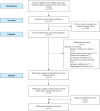Digital Gamification Tool (Let's Control Flu) to Increase Vaccination Coverage Rates: Proposal for Algorithm Development
- PMID: 39255031
- PMCID: PMC11422745
- DOI: 10.2196/55613
Digital Gamification Tool (Let's Control Flu) to Increase Vaccination Coverage Rates: Proposal for Algorithm Development
Abstract
Background: Influenza represents a critical public health challenge, disproportionately affecting at-risk populations, including older adults and those with chronic conditions, often compounded by socioeconomic factors. Innovative strategies, such as gamification, are essential for augmenting risk communication and community engagement efforts to address this threat.
Objective: This study aims to introduce the "Let's Control Flu" (LCF) tool, a gamified, interactive platform aimed at simulating the impact of various public health policies (PHPs) on influenza vaccination coverage rates and health outcomes. The tool aligns with the World Health Organization's goal of achieving a 75% influenza vaccination rate by 2030, facilitating strategic decision-making to enhance vaccination uptake.
Methods: The LCF tool integrates a selection of 13 PHPs from an initial set proposed in another study, targeting specific population groups to evaluate 7 key health outcomes. A prioritization mechanism accounts for societal resistance and the synergistic effects of PHPs, projecting the potential policy impacts from 2022 to 2031. This methodology enables users to assess how PHPs could influence public health strategies within distinct target groups.
Results: The LCF project began in February 2021 and is scheduled to end in December 2024. The model creation phase and its application to the pilot country, Sweden, took place between May 2021 and May 2023, with subsequent application to other European countries. The pilot phase demonstrated the tool's potential, indicating a promising increase in the national influenza vaccination coverage rate, with uniform improvements across all targeted demographic groups. These initial findings highlight the tool's capacity to model the effects of PHPs on improving vaccination rates and mitigating the health impact of influenza.
Conclusions: By incorporating gamification into the analysis of PHPs, the LCF tool offers an innovative and accessible approach to supporting health decision makers and patient advocacy groups. It enhances the comprehension of policy impacts, promoting more effective influenza prevention and control strategies. This paper underscores the critical need for adaptable and engaging tools in PHP planning and implementation.
International registered report identifier (irrid): RR1-10.2196/55613.
Keywords: gamification; health promotion; influenza; public health policies; vaccination coverage rates.
©Henrique Lopes, Ricardo Baptista-Leite, Catarina Hermenegildo, Rifat Atun. Originally published in JMIR Research Protocols (https://www.researchprotocols.org), 10.09.2024.
Conflict of interest statement
Conflicts of Interest: None declared.
Figures


References
-
- Seasonal influenza - annual epidemiological report for 2022/2023. European Centre for Disease Prevention and Control. [2024-12-08]. https://www.ecdc.europa.eu/en/publications-data/seasonal-influenza-annua... .
-
- WHO launches new global influenza strategy. World Health Organization. [2024-01-08]. https://www.who.int/news/item/11-03-2019-who-launches-new-global-influen... .
-
- Macias AE, McElhaney JE, Chaves SS, Nealon J, Nunes MC, Samson SI, Seet BT, Weinke T, Yu H. The disease burden of influenza beyond respiratory illness. Vaccine. 2021 Mar 15;39 Suppl 1:A6–14. doi: 10.1016/j.vaccine.2020.09.048. https://linkinghub.elsevier.com/retrieve/pii/S0264-410X(20)31209-3 S0264-410X(20)31209-3 - DOI - PMC - PubMed
-
- Omidi F, Zangiabadian M, Shahidi Bonjar AH, Nasiri MJ, Sarmastzadeh T. Influenza vaccination and major cardiovascular risk: a systematic review and meta-analysis of clinical trials studies. Sci Rep. 2023 Nov 19;13(1):20235. doi: 10.1038/s41598-023-47690-9. doi: 10.1038/s41598-023-47690-9.10.1038/s41598-023-47690-9 - DOI - DOI - PMC - PubMed
MeSH terms
Substances
LinkOut - more resources
Full Text Sources
Medical
Research Materials

